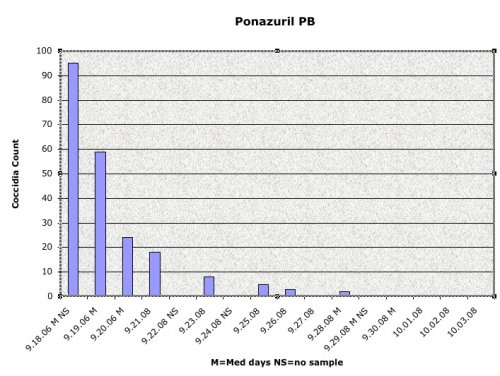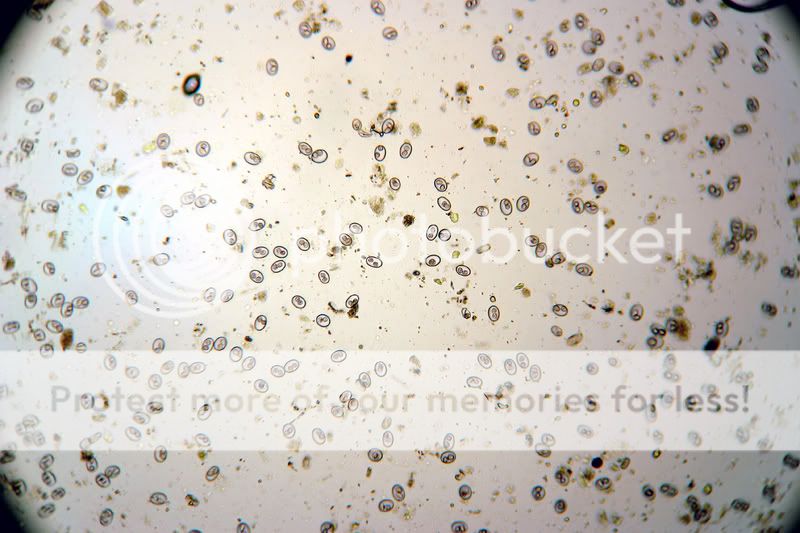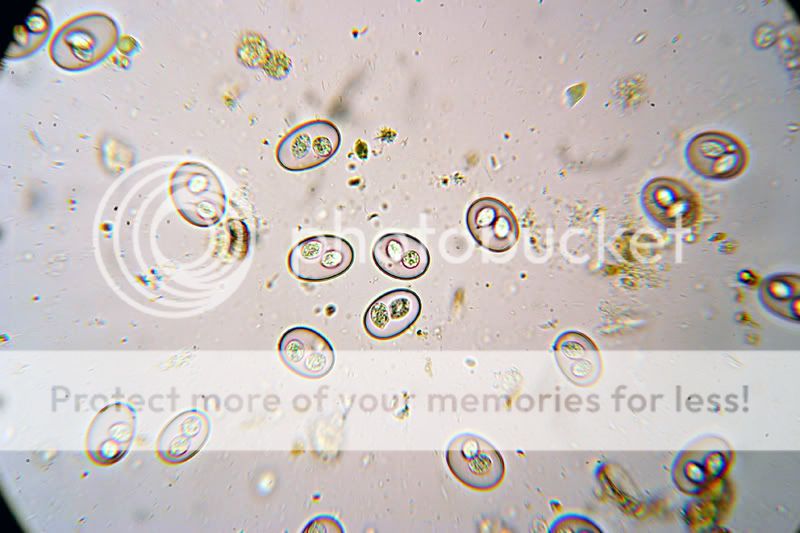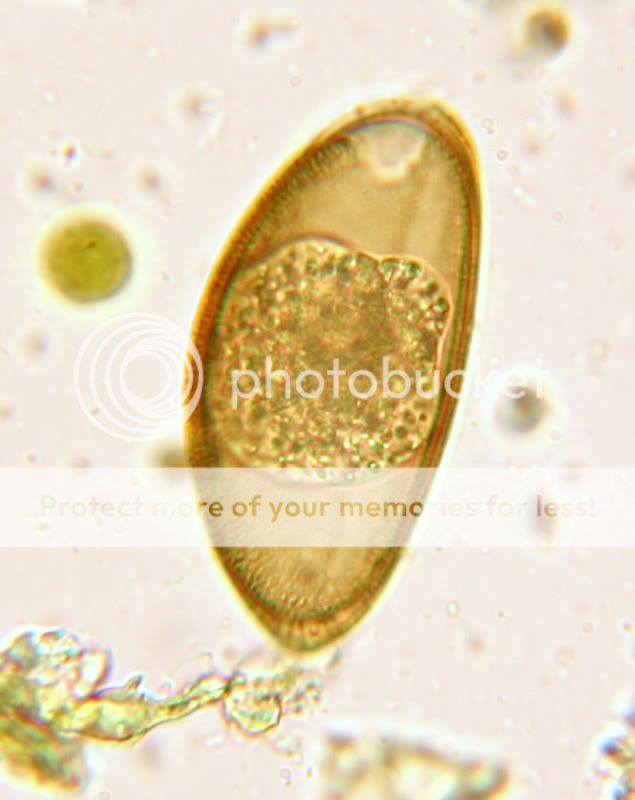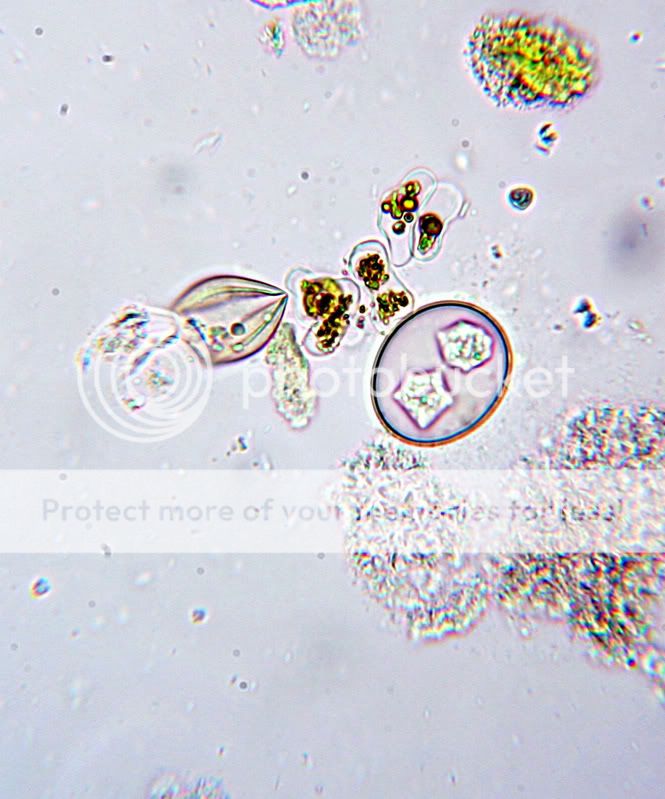luckykarma
New Member
I've been charting the effects of Ponazuril on a new animal I got at the show almost a month ago. He's a 5 month old Panther.
I started with Appertex but the animal didn't do well on it. This could've been due to providing the med orally. Each time by the 3rd day he would stop eating and become lethargic. After a day off he got energy back however by the 3rd treatment he puked the entire contents of his stomach. The same loss of appetite and lethargy followed. Others have had good success with Appertex when injected into a feeder. This is supposing the animal is eating things that could be injected, unfortunately. Appertex did start to bring the count down although with just a day off it went back up and then started to come down after treatment was restarted.
Due to that bad reaction to the Appertex in the new animal and an older animal I discussed the issue with Dave Weldon. I had wanted to attend the parasite seminar on the 2nd day of the show but luckily Dave attended.
Dr. Funk talked about a new coccidia drug called Ponazuril Dave informed me. Dave had heard about it from a person who had a Bearded Dragon. Although he never got any feedback. I called our local herp vet - Dr. Stein -who is very progressive on seeking new drugs. I mentioned Ponazuril and he needed dosages. I spoke directly to Dr. Funk who prescribed, amazingly, two treatments 48 hours apart, a full week off the med, then two more treatments 48 hours apart. 30mg/kg.
One noted caveat about Ponazuril is it was developed for horses and to buy it in packaged form is hundreds of $$. However, as Dr. Funk noted and as Dr. Stein ordered, getting it from a compound pharmacy brought the price down to $23 plus shipping. That was for an amount sufficient to cure more than a dozen animals.
Dr. Stein changed some things no doubt because he's a research maniac. I haven't gotten a chance to find out why. It appears he was correct because I dosed another animal according to the frequency Dr. Funk prescribed and it wasn't as effective. Dr. Stein upped the strength to 60mg from 50mg. He also prescribed 3 consecutive days, followed by a week off, then 3 consecutive days.
As you can see from the chart Ponazuril continued to kill coccidia for the week the animal wasn't dosed. [This is amazing considering Dave Weldon found with other drugs as soon as the animal was off it for a few days the coccidia count started to skyrocket.]
By the 9th day the animal was completely clean. As noted Ponazuril is coccidicidal as in it KILLS coccidia not merely reduces its numbers relying on the animal's immune system to do the final eradication. On the 10th day, the day I needed to start the final 3 treatments I found 1 maybe 2 coccidia. After the second 3 days of treatment he's been clean for 5+ days. If I didn't find coccidia I floated the specimen up to three times or used another part of the feces to make sure.
There was absolutely no side effects I observed using Ponazuril. The 5 month old never suffered the loss of energy or appetite. There was nothing I could see other than maybe he pooped in the afternoon rather than the morning. Since he's a new animal I don't know his cycles. After being off the drug for 3 days he does poop in the morning though.
I'm still doing research so I cannot tell you how overdose safe the drug is like Panacur. I don't think it has any of the frightening possible organ damage like Albon. I despise Albon. Everyone I talked to and all my animals that needed to be on Albon suffered badly and lost their appetite by the 3rd day. It took weeks for my animals and others I talked to in order for their Chams to eat on their own. I really suggest when your vet prescribes the knee jerk Albon you ask about Ponazuril.
Ryan sent me samples which were wall to wall coccidia. He just got a microscope and stated after 4 days it went down to 150. My guy started out with hundreds, then Appertex knocked it down some until I stopped treatment.
I know there are vets who are set in their ways and want to prescribe the tried and true in their minds. If anyone is in the L.A. area I encourage you to visit Dr. Stein at Shipps Animal Hospital in Beverly Hills. He's very progressive as mentioned and very cautious about spending your money unnecessarily. Ryan had an amazing experience whereas Dr. Stein prescribed enough to treat all his animals rather than demanding to see all the poo, do fecals, prescribe the med for each individual animal etc. Ryan got off with an office visit and $27 for the drug.
Hopefully Dave Weldon will chime in here. In his words, "Now that Ponazuril has entered the consciousness of the chameleon world, coccidia will become a simple parasite to deal with just like pinworms and roundworms and not spoken about with hushed tones in back alleys".
Also the breeder who sold all the infected animals when finally contacted by Ryan claimed it must have come from a feeder. Dave Weldon will chime in on that urban legend.
A final note. Even though this is a huge breakthrough for dreaded coccidia you still need to clean and disinfect everything. You don't want to have the animal on Ponazuril forever.
I started with Appertex but the animal didn't do well on it. This could've been due to providing the med orally. Each time by the 3rd day he would stop eating and become lethargic. After a day off he got energy back however by the 3rd treatment he puked the entire contents of his stomach. The same loss of appetite and lethargy followed. Others have had good success with Appertex when injected into a feeder. This is supposing the animal is eating things that could be injected, unfortunately. Appertex did start to bring the count down although with just a day off it went back up and then started to come down after treatment was restarted.
Due to that bad reaction to the Appertex in the new animal and an older animal I discussed the issue with Dave Weldon. I had wanted to attend the parasite seminar on the 2nd day of the show but luckily Dave attended.
Dr. Funk talked about a new coccidia drug called Ponazuril Dave informed me. Dave had heard about it from a person who had a Bearded Dragon. Although he never got any feedback. I called our local herp vet - Dr. Stein -who is very progressive on seeking new drugs. I mentioned Ponazuril and he needed dosages. I spoke directly to Dr. Funk who prescribed, amazingly, two treatments 48 hours apart, a full week off the med, then two more treatments 48 hours apart. 30mg/kg.
One noted caveat about Ponazuril is it was developed for horses and to buy it in packaged form is hundreds of $$. However, as Dr. Funk noted and as Dr. Stein ordered, getting it from a compound pharmacy brought the price down to $23 plus shipping. That was for an amount sufficient to cure more than a dozen animals.
Dr. Stein changed some things no doubt because he's a research maniac. I haven't gotten a chance to find out why. It appears he was correct because I dosed another animal according to the frequency Dr. Funk prescribed and it wasn't as effective. Dr. Stein upped the strength to 60mg from 50mg. He also prescribed 3 consecutive days, followed by a week off, then 3 consecutive days.
As you can see from the chart Ponazuril continued to kill coccidia for the week the animal wasn't dosed. [This is amazing considering Dave Weldon found with other drugs as soon as the animal was off it for a few days the coccidia count started to skyrocket.]
By the 9th day the animal was completely clean. As noted Ponazuril is coccidicidal as in it KILLS coccidia not merely reduces its numbers relying on the animal's immune system to do the final eradication. On the 10th day, the day I needed to start the final 3 treatments I found 1 maybe 2 coccidia. After the second 3 days of treatment he's been clean for 5+ days. If I didn't find coccidia I floated the specimen up to three times or used another part of the feces to make sure.
There was absolutely no side effects I observed using Ponazuril. The 5 month old never suffered the loss of energy or appetite. There was nothing I could see other than maybe he pooped in the afternoon rather than the morning. Since he's a new animal I don't know his cycles. After being off the drug for 3 days he does poop in the morning though.
I'm still doing research so I cannot tell you how overdose safe the drug is like Panacur. I don't think it has any of the frightening possible organ damage like Albon. I despise Albon. Everyone I talked to and all my animals that needed to be on Albon suffered badly and lost their appetite by the 3rd day. It took weeks for my animals and others I talked to in order for their Chams to eat on their own. I really suggest when your vet prescribes the knee jerk Albon you ask about Ponazuril.
Ryan sent me samples which were wall to wall coccidia. He just got a microscope and stated after 4 days it went down to 150. My guy started out with hundreds, then Appertex knocked it down some until I stopped treatment.
I know there are vets who are set in their ways and want to prescribe the tried and true in their minds. If anyone is in the L.A. area I encourage you to visit Dr. Stein at Shipps Animal Hospital in Beverly Hills. He's very progressive as mentioned and very cautious about spending your money unnecessarily. Ryan had an amazing experience whereas Dr. Stein prescribed enough to treat all his animals rather than demanding to see all the poo, do fecals, prescribe the med for each individual animal etc. Ryan got off with an office visit and $27 for the drug.
Hopefully Dave Weldon will chime in here. In his words, "Now that Ponazuril has entered the consciousness of the chameleon world, coccidia will become a simple parasite to deal with just like pinworms and roundworms and not spoken about with hushed tones in back alleys".
Also the breeder who sold all the infected animals when finally contacted by Ryan claimed it must have come from a feeder. Dave Weldon will chime in on that urban legend.
A final note. Even though this is a huge breakthrough for dreaded coccidia you still need to clean and disinfect everything. You don't want to have the animal on Ponazuril forever.


